Land Invertebrates
Media

Species Types
Scientific Name
Acanthoderes quadrigibba
Description
The four-humped flat-faced longhorn has no true common name, but its markings are distinctive. It plays an important role in breaking down rotten wood and enriching soils.
Media
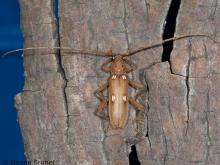
Species Types
Scientific Name
Eburia quadrigeminata
Description
The ivory-marked beetle is a longhorned beetle whose larvae bore deep into the heartwood of a variety of deciduous trees, including oak, hickory, maple, cherry, ash, elm, and more. It can live for 40 years.
Media
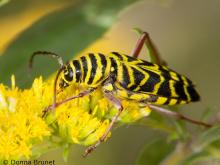
Species Types
Scientific Name
Megacyllene robiniae
Description
The locust borer is a longhorned beetle whose larvae tunnel into the trunks of black locust. The colorful black and yellow adults are often seen in late summer as they feed on the pollen of goldenrod and other flowers.
Media
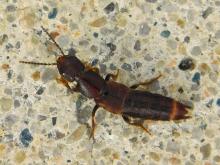
Species Types
Scientific Name
More than 4,400 species in North America north of Mexico
Description
Rove beetles usually have very short wing covers, so several of their hind abdominal segments are exposed. Typically fast movers, they often flip up their abdomen tips when frightened. This is a huge family of beetles.
Media
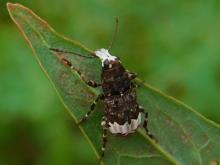
Species Types
Scientific Name
About 120 species in North America north of Mexico
Description
Fungus weevils are a family of beetles that differ from other weevils by their broad, flat bills and clubbed, but not elbowed, antennae. It's a diverse group, but many do feed on bracket mushrooms and other fungi.
Media

Species Types
Scientific Name
More than 40 species in 3 genera in North America north of Mexico
Description
Ebony bugs are definitely true bugs, but they look a lot like tiny, shiny black beetles. Their bodies are fat ovals. They’re almost always seen on flower clusters and immature seeds, often on members of the carrot or parsley family.
Media
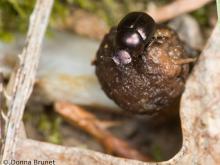
Species Types
Scientific Name
Canthon spp.
Description
Tumblebugs in genus Canthon are usually seen on, near, and beneath poop. They are sometimes seen rolling dung balls away from the original heap, heads down and pushing the ball backward with their hind legs.
Media

Species Types
Scientific Name
About 1,700 species in North America north of Mexico
Description
The scarab beetle family is very large, with breathtaking variety — and often great beauty. Many scarabs are large and colorful.
Media

Species Types
Scientific Name
Euphoria sepulcralis
Description
The dark flower scarab is a scarab beetle that apparently eats pollen, nectar, and perhaps other parts of flowers in late spring, sometimes becoming an agricultural pest. The larvae grow up beneath manure or other decaying materials.
Media
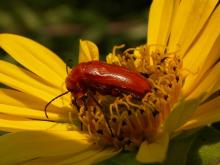
Species Types
Scientific Name
Nemognatha spp.
Description
Nemognatha blister beetles are leathery beetles often seen visiting flowers. There are nearly 30 species in North America.
See Also



Media

Species Types
Scientific Name
Cisseps fulvicollis
Description
The yellow-collared scape moth is more often “orange-collared.” And whether you think it looks more like a firefly or a wasp, it’s still a moth!
Media

Species Types
Scientific Name
Nearly 150 species in North America north of Mexico
Description
Slim, delicate plume moths are instantly recognizable by their T-shaped silhouette, long legs, and muted shades of tan and brown. It can be hard to separate the various species.
Media

Species Types
Scientific Name
Pyrrharctia isabella
Description
Not many people know the adult Isabella tiger moth when they see one, but we’re all acquainted with its caterpillar, the woolly worm, or woolly bear.
About Land Invertebrates in Missouri
Invertebrates are animals without backbones, including earthworms, slugs, snails, and arthropods. Arthropods—invertebrates with “jointed legs” — are a group of invertebrates that includes crayfish, shrimp, millipedes, centipedes, mites, spiders, and insects. There may be as many as 10 million species of insects alive on earth today, and they probably constitute more than 90 percent all animal species.





















